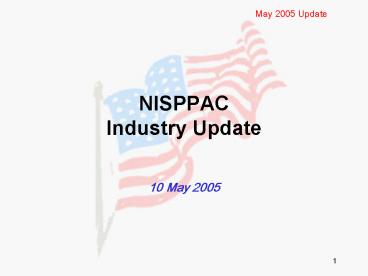NISPPAC Industry Update - PowerPoint PPT Presentation
1 / 9
Title:
NISPPAC Industry Update
Description:
Requirements for up-to-date paperwork (very common request and nothing is ... CSSWG, ISWG, ASIS and NCMS) have reworked the agreement language to include the ... – PowerPoint PPT presentation
Number of Views:58
Avg rating:3.0/5.0
Title: NISPPAC Industry Update
1
NISPPACIndustry Update
- 10 May 2005
2
Reciprocity
- Issues continue
- Agency leadership support is well documented
(Declaration of Principles on Reciprocity) - Implementation at the working level remains a
problem - Examples include
- Requirements for up-to-date paperwork (very
common request and nothing is processed until it
arrives) - If the candidate is on the 4.5 year mark for a
new investigation, access is denied pending a
complete update - The clearance for one agency of the USG can be
considered insufficient for another agency
3
Reciprocity (cont.)
- Public Trust Positions
- Lack of reciprocity impacting contractor ability
to staff positions - Examples include recent cases where HHS agencies
are not accepting active DOD clearances as
sufficient for access to public trust positions - Requiring complete package
- On a bright note - Air Force, Navy and Army
created the JAFANS To Promote Reciprocity in the
SAP/SAR Security Communities - The document was released to Industry at the Fall
2004 CSSWG Meeting and provides definitive
guidance in a number of key areas to promote
consistency in interpretation and accreditation - However, industry is concerned that failure to
secure cooperation across the USG will drain
already exhausted resources due to unnecessary
requirements for duplicate investigations
4
Reciprocity - Sensitive But Unclassified (SBU)
- Industry continues to gather details on new
versions of SBU - Requirements for handling information differ
- Defining SBU is difficult and often sweeping in
scope - Requirements for control and safeguarding are
appearing in the DD254s - The February 20, 2004 study by the Congressional
Research Service (Sensitive But Unclassified
and Other Federal Security Controls on Scientific
and Technical Information History and Current
Controversy) clearly captures the issues and
conflicting requirements
5
Reciprocity/SBU - Recommendations
- Industry proposes a working group within the
NISPPAC to further work the requirements for
clearances and public trust positions and propose
solutions to the current stove pipes - We need to find solutions to support cross
communication between agencies as the growth of
classified-like accesses continue - Industry also proposes a working group within the
NISPPAC to make recommendations on creating a
standard for the definition and protection of
sensitive information - Allowing SBU to be defined locally will only
exacerbate the growth
6
AIS/Chapter 8 White Paper to DSS
- Industry, via the MOU/NISPPAC prepared a white
paper regarding improvements needed in system
accreditation and approval for classified systems
which was delivered to DSS in March, 2005 - DSS accepted the paper and has proposed two
working groups to meet as early as this month - One working group will focus on system
accreditation cycle time and the other on ISSM
self certification authority - DSS has appointed an internal lead for the
working group and has asked the NISPPAC/MOU to
also propose a lead to partner with theirs - Industry is pleased at the responsiveness of DSS
to work this problem
7
Other Issues for 2005
- Substandard Containers
- AIA s ISC took the lead on surveying Industry
regarding substandard containers. NISPOM Chapter
5-302 requires that these containers be
eliminated by 2012. - Industry suggests that most are being used in
Closed Areas and create little risk to the
protection of the classified information they
protect - Other issues related to the transfer are lack of
more than one vendor for the safes and floor load
issues in some buildings that make the safes
impractical - Alarm Response NCMS lead
- DSS interprets the NISPOM Chapter 5 -903 as
requiring guards to respond to all alarms and
does not allow for cleared personnel to respond - This interpretation is delaying the approval of
IDS systems and requiring additional expenditures
in small company/site operations. - An additional question in the NCMS survey
regarding the cause of the alarm showed,
overwhelmingly, that alarms were not due to
unauthorized entry, but instead internally caused
by employees closing late or failing to follow
procedures - Industry will continue to work this issue in the
hopes of securing common approach to alarm
response
8
Other Issues for 2005(cont)
- DHS/ICE Verification of alien status
- Currently verification of authenticity of proof
of Permanent Residency may only be accomplished
through the Department of Homeland Securitys
(DHS) Immigration and Customs Enforcement unit
(ICE) - The system is being beta tested in a number of
states but it not available in all areas - Further, the system requires that only employers
process their individuals and most of our
candidates are contractors - Forgeries are excellent and cannot be easily
detected. - Verification of authenticity of the documentation
is significantly more important in the defense
industry where ITAR controlled information is
unavoidable - Immigrant aliens (green card status) are being
used as knowledge workers by industry - Industry needs the assistance of DHS to work this
issue and to help in expanding the resources to
check all immigrants directly employed or
working within our facilities
9
MOU Agreement Revision
- The signatories (AIA, NDIA, CSSWG, ISWG, ASIS and
NCMS) have reworked the agreement language to
include the NISPPAC industry representatives - Wording now incorporates language stressing
cooperative approaches to common issues but
recognizing organizational independence - Agreement now calls for the election of a
Director who has to be from the signatory
organizations or a NISPPAC member - Draft is in final review with an end of May
target for approval - The NISPPAC industry representatives view this as
the best way to try to reach as many constituents
of the NISP as possible































